#cultivated south sea pearls
Explore tagged Tumblr posts
Text


Half & half
South sea cultivated pearls and 18kt gold chain.
#tousjewelry#gems#gemstones#tous#jewelry#style#rosatous#tous atelier#cultivated south sea pearls#18ktgold#tous style
2 notes
·
View notes
Text
"Discarded shells from restaurants and hotels are being used to restore damaged oyster ecosystems, promote biodiversity and lower pollution in the city’s bays...
Nestled in between the South China Sea and the Pearl River Delta, Hong Kong has been seen historically as an oyster hotspot. “They have been supporting our livelihood since ancient times,” says Anniqa Law Chung-kiu, a project manager at the Nature Conservancy (TNC) in Hong Kong. “Both oysters and their shells are treasures to humans.”
Over the past five decades, however, the city’s sprawling urban development, water pollution, as well as the over-harvesting and frequent seafloor dredging by the lime industry – which uses the crushed shells to make construction material – have destroyed Hong Kong’s oyster habitats and made the waters less hospitable for biodiversity.
The more oyster colonies falter, the worse the problem gets: oysters are filter feeders and purify water by gobbling up impurities. Just one Hong Kong oyster can filter up to 200 litres of water a day, more than any other known oyster species. But decades of rapid industrialisation have largely halted their water-purifying services.
The depletion of Hong Kong’s natural oyster reefs also affects the ability of local farmers to sustainably cultivate their oysters in a healthy environment, denting the reputation of the city’s 700-year oyster farming tradition, designated by Unesco as an “intangible cultural heritage”.
Inhabitants of the coast feel abandoned, says Ken Cheng Wai-kwan, the community leader of Ha Pak Nai on Hong Kong’s Deep Bay, facing the commercial city of Shenzhen in China. “This place is forgotten,” Cheng says. “Oysters have been rooted here for over 400 years. I ask the question: do we want to lose it, or not?”
A group of activists and scientists are taking up the challenge by collecting discarded oyster shells and recycling them to rebuild some of the reefs that have been destroyed and forgotten in the hope the oysters may make a comeback. They’ve selected locations around the island where data they’ve collected suggests ecosystems still have the potential to be rebooted, and there are still enough oyster larvae to recolonise and repopulate reefs. Ideally, this will have a positive effect on local biodiversity as a whole, and farming communities.
Farmers from Ha Pak Nai were among the first to hand over their discarded shells to the TNC team for recycling. Law’s team works with eight oyster farmers from Deep Bay to recycle up to 10 tonnes of shells every year [over 22,000 pounds]. They collect an average of 870kg every week [over 1,900 pounds] from 12 hotels, supermarkets, clubhouses and seafood restaurants in the city, including some of its most fashionable establishments. About 80 tonnes of shells [over 176,000 pounds] have been recycled since the project began in 2020.
Restaurants will soon be further incentivised to recycle the shells when Hong Kong introduces a new fee for waste removal – something that is routine in many countries, but only became law in Hong Kong in July and remains controversial...
Preliminary data shows some of the restored reefs have started to increase the levels of biodiversity, but more research is needed to determine to what extent they are contributing to the filtering of the water, says Law.
Scientists from the City University of Hong Kong are also looking to use oyster shells to increase biodiversity on the city’s concrete seawalls. They hope to provide tiny, wet shelter spots around the seawall in which organisms can find refuge during low tide.
“It’s a form of soft engineering, like a nature-based solution,” says Charlene Lai, a research assistant on the team."
-via The Guardian, December 22, 2023
#oyster#oyster farming#sea shells#seafood#hong kong#ecosystem restoration#biodiversity#ecosystem#water pollution#clean water#cultural heritage#marine life#marine animals#marine science#good news#hope
809 notes
·
View notes
Text
Chapter 15: Your Horse is Dead
Fun Fact #1: budding legends around the historical Xuanzang already featured an extraordinary horse.
Fun Fact #2: and it's not a white horse, but a skinny red one.
-The unnamed old horse was gifted to Xuanzang by an elderly foreign man, who was an experienced traveller of the western roads. Later, while Xuanzang was crossing the desert, he lost his way and was about to die of thirst; suddenly, the horse took a different road on its own accord and saved the day by bringing him to an oasis.
-Because red is associated with fire, and horses turning into dragons was already a well-known trope in Chinese legends and folklore, said horse evolved into a Fire Dragon Horse in folk operas and retellings.
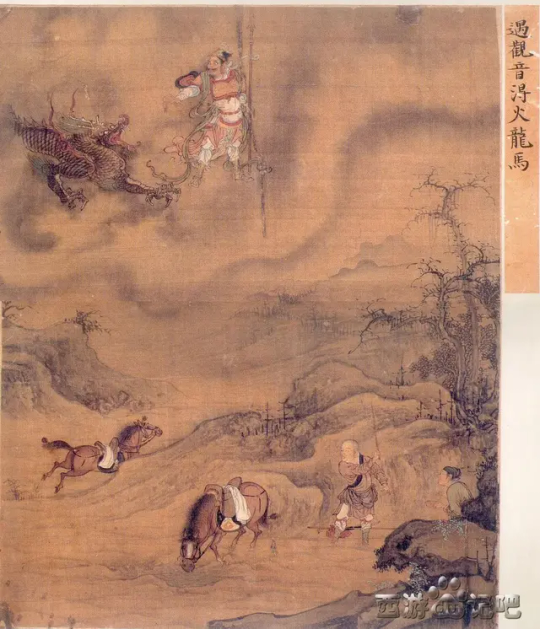
-In Yang Jingxian's JTTW Zaju, the horse was originally a fire dragon of the South Sea, who, strangely, was sentenced to death for failing to summon rain on schedule.
-Precious Scroll of the True Scriptures (真经宝卷), which came into existence around early Ming, also featured the Third Fire Dragon Prince, and his role was a lot more prominent than in the novel; after Sandy was forced to retreat into the river by SWK, he gave chase and stirred up the whole water body, and when this version of the seven spider demonesses used their silk to seize the pilgrims' weapons, the horse reverted to his dragon form and burnt away the silk with his flames.
-But since "White Horse Carrying the Scriptures" is a keystone imagery in the legends of Buddhism's spread to China, the horse also got a recolor in the Journey stories, and its association with fire gradually weakened, until all that was left was the arson of the dragon pearl in JTTW novel.
-Sidenote: the book only explicitly associated Metal with SWK, Wood with Pigsy, and Earth with Sandy, since in the specific tradition of internal alchemy it followed, Water is basically packaged together with Metal, and Fire with Wood.
-However, if you really wanna associate each of the pilgrim with one of the Five Elements? Tripataka would be Water (River-Float Boy) and the Dragon Horse would be Fire, based on his earlier incarnations as the Fire Dragon Horse.
-The Six Gods of Light and Six Gods of Darkness(六丁六甲) was based on the Ten Celestial Stems, a system of ordinals that, combined with the Twelve Earthly Branches, formed the 60 days/years calendrical cycle. As the personifications of those ordinals, these gods had a long history of being summoned by Daoists for divination and bodyguard duty, going all the way back to Eastern Han.
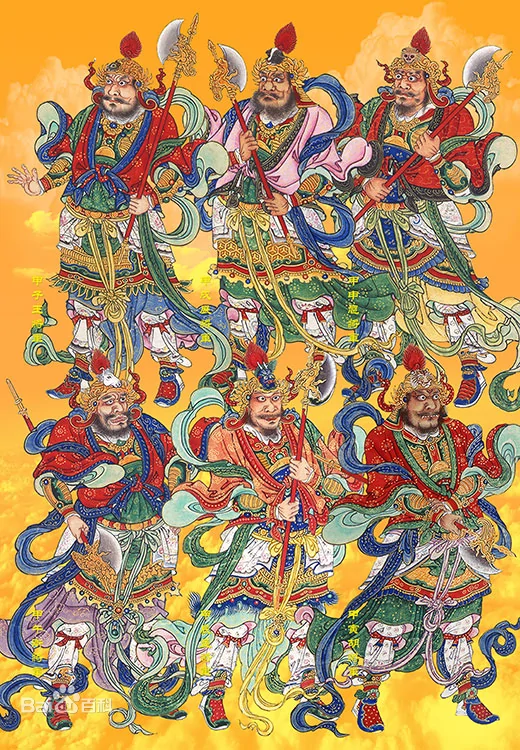
-The Yu edition might have translated them as the gods of Light and Darkness because traditionally, the Six Ding Gods were female and thus Yin-aligned, while the Six Jia Gods were male and Yang-aligned.

-When Guanyin turned the white dragon into a horse, the Yu translation said he "[holds] the bit in his mouth". Well, in the original Chinese, it says 口衔着横骨, literally "holding the horizontal bone in his mouth".
-This is a reference to the old Chinese folk belief that animals couldn't talk because there were a piece of hard bone inside their mouths/throats; only cultivated animals would be able to get rid of it.
-So yeah, the white dragon was very, very dedicated to his horse roleplay, down to the fantastical throat cartilage part.
@journeythroughjourneytothewest
27 notes
·
View notes
Text
What are the most popular types of pearls used in jewelry today?
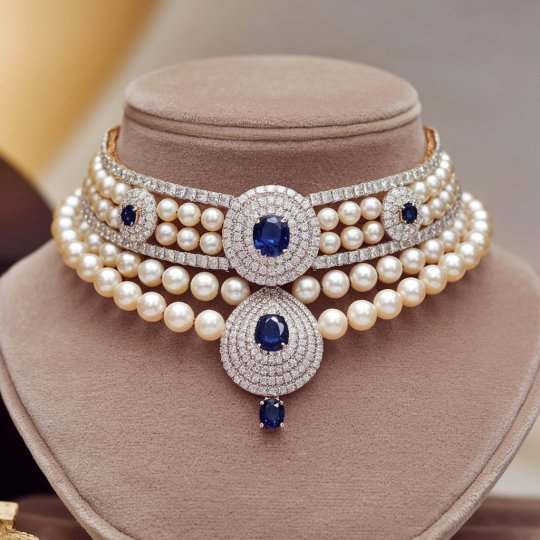
Akoya Pearls: Known for their classic, mirror-like shine and perfect round shape, Akoya pearls are the epitome of traditional pearl jewelry.
Tahitian Pearls: Unlike the typical white pearls, Tahitian pearls captivate with their exotic dark hues.

South Sea Pearls: Renowned for their impressive size and luxurious golden or white colors, South Sea pearls are among the most sought-after in the world.


Freshwater Pearls: Versatile and widely available, freshwater pearls are known for their diverse shapes, sizes, and colors.
Keshi Pearls: These unique pearls are actually a byproduct of pearl cultivation, formed without a nucleus, which gives them their irregular shapes.
#jewelry#3dmodelofjewelry#jewelrymaking#earrings#jewelry3d#pearl jewelry#necklace#pearls#cultured pearl necklaces
5 notes
·
View notes
Text
"Demons", Gods, and In-betweens in the Series: Love and Redemption (Part 1)
There are many non-human Chinese mythical creaturesthat appeared in the tv series Love and Redemption(LnD), especially 妖怪(translated as “demons”). I find this subject extremely interesting so I'm going to try summarize them and record their first historical appearance if possible. Many of them come from an ancient book called The Classic of Mountains and Seas 山海经(the Classic). It was written sometime around 4th to 5th century BC. So it's probably one of the oldest books that survived. And it is a source of inspiration for the entire history of China for those who write the monster and strange occurrence tales. In this post I will try to include descriptions about the relevant mentions of the "demons" from the Classic and other sources, although I'm sure better translation already exist.
* The reason I said “translated as demons” and not just use “demons” directly is because they are really not the same concept. There is little to no religious meaning to 妖怪. If you have to squint, 妖怪 likely popularized because ancient Chinese believe that everything have spirit and potential to gain wisdom and transform into higher beings. So in later time like Tang to Qing dynasties there are many 妖怪 that developed from nonhuman animals or plants in such stories, sometimes even objects. But there are also naturally occurring creatures that sometimes are monsters, sometimes gods or semigods in charge of certain functions like wind, thunder, natural disasters etc. like many of those described in the ancient Classic of Mountains and Seas.
烛龙Torch Dragon
First appearance: the Classic [山海經], 2 entries, around 4th century BC
In the Classics of Montains and Seas it is said to be a torch-bearing dragon that shines light in the night-folds darkness. It creates day and night, summer and winter by opening and closing its eyes and breathing in and out. Obviously an ancient god.
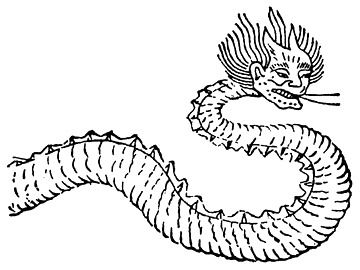
In our show, a spirit/ghost of the torch dragon was summoned to guard the Colored-Glass Lamp in heroine’s sect Shaoyang. It is a much less powerful version of the Torch Dragon but still created a lot of trouble for our protagonists. It seems that the spirit/ghost of Torch Dragon cannot truly be killed because it can be resummoned.

鲛人 Fish-person or merman
First appearance: the Classic [山海經‧海內南經], around 4th century BC
A non-human tribe living in the South Sea. It is basically translated to merman because they have an upper human body and a fish tail, although it has nothing to do with the western version the phrase usually refers to. Unlike their western counterparts, they are said to be tame and mild, good at producing a specific type of beautiful clothes that won’t get wet in the water, and when they cries their tears turn into pearls. In later stories they are often depicted as victims of humans’ greed and lust.

In LnD we see one important side character that is Tingnu, who is a doctor and used to serve in the court of heaven’s realm, although in the show merpeople are categorized as demons. He was the first demon that our protagonists encountered that made them questioned their concept of right and wrong that was taught to them.
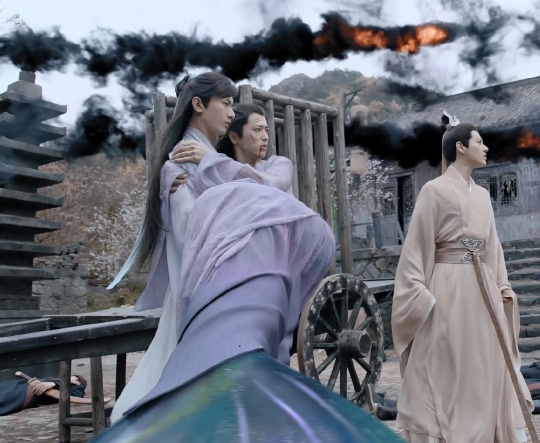
蛊雕 Gu Eagle
First appearance: the Classic [山海經‧南山经], around 4th century BC
This is an eagle-like, water-dwelling monster with horn on its head that eat people. It is said to live on a mountain rich with minerals with no flora.
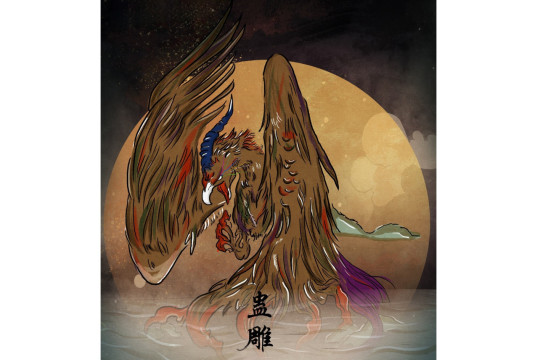
In LnD Gu Eagle is the first major dangerous demon our protagonists encountered. It needs to be noted that unlike the merman who is a “naturally-occurring humanoid being”—born with a humanoid shape. The Gu Eagle in LnD was said to have cultivated for 500 years and was on the verge of gaining a human shape. It was quite powerful that even the elders of the Righteous Sects don’t dare face it alone and instead grouped together and prepared themselves fully. Our protagonists had no chance against it at that stage, or so they thought.
瞿如鸟 Qu Ru Bird
First appearance: the Classic [山海经·南山经], around 4th century BC
It is said to be a bird of white head, three legs, and a human-like face. It lives on a mountain rich with gold and jade, and populated by animals such as rhinos and elephants.

The shows’ Qu Ru Birds are very different from those described there. In the show, Quru birds appeared as a swarm of dark greenish colored birds that was able to attack humans, but don’t seem like much different than regular animals. They were controlled by a Ao Yin to drive away humans and collect certain herbs. Eventually Sifeng let them escape after Ao Yin was killed.
傲因 Ao Yin
First appearance: It is said to first appear in [山海經] but the description differs greatly from later stories. We will take later descriptions during the Jin Dynasty because they are closer to what appeared in the show:
Au Yin is said to be a humanoid creature with very long tongue, wears shaggy clothing with many knots and has a taste for human brains. It lives in the west-wasteland and attacks lone travelers to eat their brain.
攫(玃)猿
First appearance: (probably) Accounts of Strange Things [述異記] by Zu Chongzhi 200–265 AD
This is a giant monkey-like creature that was said to abduct human females to impregnate them and then send them back home to rear the child. If they refuse it kills the woman. Obviously it is a monster. Funnily enough it seemed to have traveled to Japan in the Edo era(1603~1867)and was called kakuen locally. It was written in the Japanese encyclopedia Wakan Sansai Zue of the same time to be a type of "yamako" (玃), which is the same character as the Chinese version.
In our show this monster appeared as a serial killer who target newly-weds due to his hatred of a female cultivator who seriously wronged him. Our protagonists chased him to his “burial site” and killed him because, well, he is a serial killer who targeted innocent people.
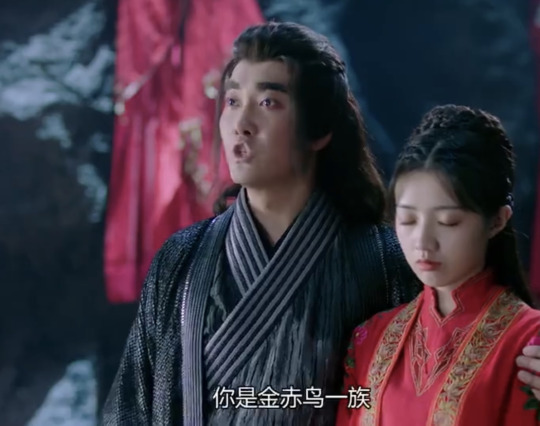
TBC
#Yao Guai#妖怪#Yokai#Chinese culture#ancient culture#the Classic of Mountains and Seas#Love and Redemption
17 notes
·
View notes
Note
YOU 🫵. 13 !!
IVE BEEN GOTTEN!!!
13. Which of the pearls is your favorite?
This one is SO DIFFICULT but I will try to narrow it down. I'm gonna stick with non-DP pearls for now, though I might return and add some. These are all pulled from the wiki.
I love the dark pink pearl from shaded citadel for how it humanizes (for lack of a better word) an individual ancient. It's just so fun- "Artist, Warrior, and Fashion Legend." The pink farm arrays pearl- the Small Plate- also has some very strong details about the ancients on it. Getting to hear Moon's humorous description of the echoes is such a treat. The green drainage system pearl makes me feel.. so much. "I know I have tried very hard." The hunter pearl also makes me feel a lot, to the point where I wrote down a bunch of theoretical gameplay changes to give it more importance.
I have a couple favorite white pearls.. generally because of the little snapshots of the world and implications they contain.
"This is an official decree of cultivation sent from the twenty-second Subsistence Council ordering the eastern spoke Farm Array administration to "immediately harvest and process all viable crops, despite whatever misgivings they might have." A short-sighted endeavor for sure. I would assume this was sent sometime during the final cycles leading up to final public ascension, when interest in biosphere sustainability was at an all-time low." My first white pearl I got Moon to read was this one!! I still remember it. It happens to be one of the longer ones, and there's a lot of good details.
"Oh, interesting. This is a diary entry of a pre-Iterator era laborer during the construction of the subterranean transit system south of here. In it they describe restless nights filled with disturbing dreams, where millions glowing stars move menacingly in the distance." Raises so many questions about the void sea!! To an extent, confirms some level of reality or consistency to what we see down there. It makes Subterranean as a region feel so much cooler, IMO.
"It's a catalog of bolts and screws for sky-sail joinery. We iterators were built for pragmatism, so it is an understatement to say that we were not known for our appreciation of beauty... but the sky-sails in flight during the big festivals always filled my soul with emotion." Her SOUL... it's such a lovely pearl.
2 notes
·
View notes
Text
The Dream-titans of Gaggunaŕkul, the Fuligin City
A band of Titans under the influence of the Tower-within-Dreams establish a empire in southern Tuula, reliant on slavery, dream magic and blood magic.
After the scattering of the pearls, great many Titans awoke in the wildernesses of southern Tuula, which was inhabited by fewer other mortals. The Titans gathered in small communities as their whims took them, and many of them fell under the sway of the Tower-Within-Dreams.
One band of Titans had a particularly strong connection to the Tower, and these Titans dreamt of it often. When they scaled its heights they learned the secrets of bewildering the minds of other mortal folk, or of disquieting them until they flee, or trapping their thoughts in circles. This band named themselves the Havonaar, and they migrated across all of southern Tuula, searching for something they could not name. For many decades they served as mercenaries in the Sanguinary Wars; they learned the blood magic of the Dzadek from magisters who they captured and tortured with visions of the Tower, and learned many other secrets besides.
As the League of the South was founded and the Sanguinary Wars came to an end, the Havonaar departed the lands of the Dzadek. They journeyed south and west, towards the sea, where they took what the desired from the communities of TItans and Usfir that dwelt in the region. Yet still they were unsatisfied. Hearing of the existence of the Reflecting Gallery intales from distant Thorfuidir, many of the Havonaar grew avaricious, and decided to claim the bounty of knowledge within for themselves.
With their power over Dreaming, it took little effort for the Havonaar to enter the Reflecting Gallery. They explored there for a while, and learned many secrets before their intrusions were caught by the Seraki who acted as curators of the Gallery. The curators expelled them utterly, and many of the Havonaar woke to find themselves struck blind, or unable to move, or with their senses jumbled. Some never woke at all. But the damage was done.
Journeying towards the ocean, the Havonaar sought out two Deep Ones whom they had learned of; Sīnobbe and Alēmdanna. They enticed the two Deep Ones to put forth drones to commune with them, trapped the minds of the drones, and carried them off to their camp to bind them with Dzadeki magics. With the Deep Ones enslaved to their command, the Havonaar embarked on a campaign of conqest, eager to imitate the victories of VOrul whom they had heard about, far to the north. They enslaved other Titans and Usfir who dwelt in the region, and with the labour of their slaves and bound drones they raised the great temple-city of Gaggunaŕkul. Miles across, the city is a maze of great ziggurats, deep pools touched by dreaming magic, long galleries decorated with frescos of terrors and wonders glimpsed in dreams, wide shallow basins where algae is cultivated for bound drones, arenas where slaves fight for the amusement of the Havonaar, and slums where the slaves dwell.
Once the stone of the city was grey and white, yellow and red, brown and beige, but over time all colour has faded out of it, replaced with an oily blackness. In the day it is a place where the sun’s light is weakened; at night it is a place of utter blackness, a abyss in the form of a city. And beneath a full moon, it is a city where dreams can walk the waking world, the Black Tower looms in any direction you look, and slaves make desperate attempts to escape into the safety of the worlds of dream.
Yet even as their power waxed, the Havonaar began to struggle. The sleep of the Titans came upon them more and more, and they struggled to maintain unity; each Havonaar was suspicious of the others, and expected others to attack them for their own gain while in deep slumber. To solve this, the Havonaar began to bind themselves to each other with their stolen magics, binding vows to do no harm or support each other or carry out each others duties when one slumbered into their own blood. Yet these vows did not stop the Havonaar from scheming; they merely forced the Havonaar to become cunning about the ways they sought power within their fractious community.
At any one time the majority of Havonaar are asleep and Dreaming; those awake fulfil their vows, scheme for power within the confines of their contracts, and advance the power of the Havonaar as best they can. The Havonaar are steadily growing in number, but older Havonaar also spend longer asleep, and the need to maintain control over their vast populations of slaves and keep Sīnobbe and Alēmdanna bound limit the ability of the Havonaar to exert their great power on the wider world. But the Havonaar are Titans, and Titans are patient creatures. The day is coming when the Havonaar will send their armies northwards, desiring more slaves, more bound spirits, and more knowledge of the secrets of the world.
5 notes
·
View notes
Text
Affordable Luxury: Top Jewellery Brands for Every Budget

Explore the finest heritage jewellery in Kuala Lumpur, Malaysia, where timeless designs meet expert craftsmanship. Discover the latest gold rings in KL, Malaysia and elegant gold mangalsutra in KL, Malaysia, designed to suit any occasion. Experience the charm of heritage and elegance in every piece that showcases unparalleled quality.
As of December 16, 2024, here are the latest developments in the gold jewellery sector:
Superdrug's Jewellery Clearance
Superdrug stores have significantly reduced prices on various jewellery items, including rings, necklaces, and earrings, with some pieces priced as low as 10p. This clearance has attracted numerous shoppers seeking affordable accessories and Christmas stocking fillers. Customers have reported finding sterling silver earrings for 10p and watches for 49p or £1.50. Fashion experts note that Superdrug's jewellery range includes over 150 pieces online, many priced under £10.
Monica Vinader's Black Friday Sale
Monica Vinader's Black Friday sale offered up to 50% off on a wide range of luxury jewellery. The sale included daily flash deals on pieces favored by celebrities like Kendall Jenner and Princess Kate. Highlighted deals featured Siren Wire Earrings reduced to £70.40 from £128 and Skinny Eternity Rings for £149, down from £298. The sale, which started on November 18, concluded on December 4 and was available on the Monica Vinader website and other major retailers.
Affordable Luxury Jewellery Brands
A recent article highlighted the top affordable luxury jewellery brands for 2024, showcasing various styles from dainty necklaces to bold statement pieces. Brands such as Gorjana, Kendra Scott, Mejuri, and BaubleBar were noted for their affordability and unique designs. Sustainable options like Ana Luisa and ethically sourced diamonds from Brilliant Earth were also featured. The article provided details on each brand’s price range, shipping policies, and standout pieces, assisting consumers in finding high-quality, stylish jewellery without overspending.
Impact of Climate Change on Pearl Prices
The resurgence of pearls in 2024 has been accompanied by significant price increases due to climate change and labor shortages affecting pearl cultivation. Prices have surged by up to 50%, impacting all types of pearls, including Akoya, freshwater, and South Sea varieties. Pearl farming's sensitivity to oceanic conditions has heightened awareness of environmental challenges, prompting brands to invest in sustainability initiatives to ensure ocean health. Designers are adopting creative solutions, such as using vintage pearls or stockpiling supplies, to address these challenges while maintaining quality and raising environmental awareness.
Mandatory Hallmarking Expansion in India
India has expanded its mandatory gold hallmarking program to 18 more districts, bringing the total to 361. Since its launch in June 2021, over 40 crore gold jewellery pieces have been hallmarked, enhancing consumer trust. The program has also led to a surge in registered jewellers and assaying centers, ensuring the authenticity and quality of gold jewellery in the market.
Customize your style with exclusive custom gold ornaments in KL, tailored to your unique preferences. Choose from an exquisite range of gold pendants in KL, Malaysia, crafted to perfection. Visit us to experience bespoke artistry and find jewellery that truly reflects your individuality!
#custom gold ornament in KL#custom gold ornaments in KL#gold pendants in KL malasiya#gold mangalsutra in KL malasiya#gold chain in KL malasiya#gold ornaments in KL malasiya#latest gold pendants in KL malaysia#Gold Jewellery Shop in KL#gold jewellery shop in kl malaysia#gold jewellery shop in kuala lumpur#gem stones in KL malaysia#gold necklace in KL malasiya#latest gold rings in kl malaysia#gold rings in KL malasiya#gold jewellery KL#Jewellery Shop in KL#Jewellery Shop in KL malasiya#Jewellery Shop in Kuala Lumpur#best jewellery shop in malaysia#gemstones in kuala lumpur#gemstones in KL malaysia#gemstones in KL#jewellery shop in kuala lumpur malaysia#gem stones in malaysia
0 notes
Text

Japan has long been renowned for producing some of the finest and most exquisite pearls in the world. Among the different types of pearls cultivated in Japan, Akoya Pearls are the most famous and widely recognized. Known for their exceptional luster and round, symmetrical shape, Akoya pearls are often referred to as the "classic" pearl, ideal for fine jewelry. Another notable type is the Tahitian Pearl, although originally from French Polynesia, Japan has contributed significantly to their cultivation through advanced techniques. South Sea Pearls, grown in the warm waters surrounding Japan, are prized for their large size, luxurious texture, and range of natural colors from white to golden hues. These pearls are often more rare and expensive, known for their understated elegance. Finally, Freshwater Pearls are also cultivated in Japan, though they are less common than their saltwater counterparts. These pearls are highly valued for their natural, irregular shapes and vibrant range of colors. With Japan’s long history of pearl cultivation, each type holds a distinct place in both the world of jewelry and in cultural significance, making them not only a symbol of beauty but also a testament to Japanese craftsmanship and innovation.
#pearl gemstone#pearl gemstone price#pearl gemstone benefits#pearl gemstone ring#original pearl gemstone#certified pearl gemstone#white pearl gemstone#benefits of wearing pearl gemstone#is pearl a gemstone
0 notes
Text
The Timeless Beauty of Pearl Gemstones: A Complete Guide
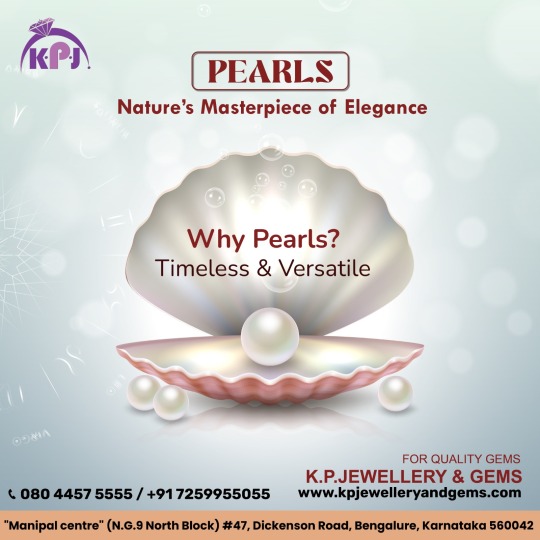
Pearl gemstones, also known as Moti in many cultures, have captivated humanity for centuries with their lustrous beauty and serene charm. Unlike other gemstones that are extracted from the earth, pearls are formed by living creatures, making them distinct in both their creation and significance. Whether used in jewellery or regarded for their healing properties, pearls continue to remain symbols of grace and elegance across the world. In this complete guide, we’ll explore the timeless allure of pearl gemstones, their types, symbolism, and how they can be incorporated into your life.
Pearl Jewellery Shops in Bangalore
1. The Origin of Pearls: A Natural Wonder
Pearls are formed through a captivating natural process. They form inside the shells of certain mollusks, primarily oysters and freshwater mussels, when an irritant, such as a grain of sand, enters the shell. In response, the mollusk secretes layers of a substance called nacre around the irritant, forming the lustrous pearl. This process can take years, making pearls rare and precious.
2. Types of Pearls: From Classic to Contemporary
There are several types of pearls, each with its own distinct characteristics and appeal:
Saltwater Pearls: These pearls are formed in oysters in the ocean and are often known for their smooth texture and round shape. Famous varieties include Akoya, Tahitian, and South Sea pearls. Akoya pearls are typically smaller and whiter, while Tahitian pearls come in darker shades of green, black, and purple.
Freshwater Pearls: These are cultivated in freshwater mussels, mainly in China. They tend to have more irregular shapes and a wider range of colours, from white and pink to lavender and peach.
South Sea Pearls: Known for their large size and creamy, golden hues, South Sea pearls are one of the most sought-after types and are often associated with luxury.
Tahitian Pearls: These pearls are unique for their dark, exotic colours ranging from green to blue and black. They are often larger and have a thicker nacre layer than Akoya pearls.
Each type has its own charm and value, but all are prized for their timeless beauty.
3. The Symbolism of Pearls: Beauty and Wisdom
Pearls have deep cultural and spiritual significance in many societies. Historically, they’ve been seen as symbols of purity, wisdom, and wealth. In ancient Rome, they were considered a symbol of status and were reserved for royalty. In Hinduism, pearls are believed to bring emotional balance and enhance love and compassion.
In modern times, pearls symbolize grace, femininity, and sophistication. They are often given as gifts on significant occasions like weddings or anniversaries to represent the timeless beauty of the wearer’s love and commitment.
Pearl Jewellery Shops in Bangalore
4. The Healing Properties of Pearl Gemstones
Pearls are not only revered for their aesthetic qualities but also for their healing properties. Many believe that wearing a pearl gemstone can bring about emotional healing, promoting peace, calmness, and balance in one’s life. They are thought to help with stress relief, reduce negative emotions, and foster better communication.
In astrology, pearls are associated with the Moon, and are believed to enhance the wearer’s intuition and emotional strength. They are often recommended for people who are sensitive or prone to emotional imbalance, as pearls are said to have a soothing and stabilizing effect.
5. How to Choose the Perfect Pearl Gemstone
Choosing the right pearl gemstone is a personal journey, as it depends on your aesthetic preferences, budget, and what you wish to gain from its symbolism or healing properties. Here are a few tips for selecting the perfect pearl:
Size and Shape: Pearls come in a variety of sizes, from tiny seed pearls to large South Sea pearls. Their shape can also vary, with round pearls being the most coveted, while baroque (irregular) pearls offer a unique, contemporary appeal.
Luster: Luster refers to the shine and reflective quality of a pearl. Pearls with higher luster are considered more valuable. Look for pearls with a bright, smooth, and reflective surface.
Surface Quality: Pearls can have surface imperfections, such as bumps or spots, which affect their overall appearance and value. The fewer the imperfections, the higher the quality.
Colour: While white pearls are classic, they come in various shades, including cream, pink, black, and golden. Select a colour that enhances your skin tone and matches your personal style.
Origin: Pearls from different regions can vary in price, with South Sea and Tahitian pearls being some of the most expensive due to their rarity and size.
6. Caring for Your Pearl Jewellery
Pearl gemstones require special care to maintain their beauty. Unlike other gemstones, pearls are more delicate and can be easily scratched or damaged by harsh chemicals. To preserve their luster, keep your pearls away from perfume, makeup, and harsh cleaning agents. Store them in a soft cloth pouch to prevent scratches and ensure they stay in pristine condition.
Gemstone Shop in Bangalore
7. Pearls in Modern Jewellery
Pearls have experienced a resurgence in modern jewellery design, blending classic elegance with contemporary styles. Today, pearls are incorporated into a wide range of jewellery pieces, from minimalist necklaces to bold statement earrings. Whether you prefer traditional pearl studs or a more eclectic design, pearls remain an essential and timeless addition to any jewellery collection.
Conclusion
Pearl gemstones are the epitome of timeless beauty, offering not just a stunning aesthetic but also deep symbolism and healing benefits. From their natural formation process to their cultural significance, pearls continue to captivate and inspire people around the world. Whether you’re looking to add a pearl piece to your collection or seeking the emotional and spiritual benefits they offer, pearls remain as relevant today as they were centuries ago.
If you’re in search of a gemstone that embodies elegance, grace, and a deep connection to nature, the timeless beauty of pearls is sure to leave a lasting impression.
#best pearl jewellery shops in Bangalore#pearl jewellery shops in Bangalore#gemstone shop in Bangalore#pearl jewellery in Bangalore
0 notes
Text
Discover Elegance: Buy South Sea Pearl Jewellery Sets Online in India
When it comes to timeless beauty and sophistication, South Sea pearls stand unparalleled. Known for their luminous sheen and exceptional size, these pearls are the epitome of luxury. For those looking to invest in stunning pearl jewellery, Kantilal Exports offers a diverse selection of South Sea pearl jewellery sets available online in India.

Buying pearl jewellery online has never been easier or more convenient. At Kantilal Exports, you can explore an exquisite range of South Sea pearl necklaces, earrings, and complete jewellery sets from the comfort of your home. South Sea pearls, with their natural golden and white hues, exude an opulence that can elevate any outfit, from casual wear to formal attire.
Why Choose South Sea Pearls?
South Sea pearls are renowned for their large size, smooth surface, and incredible luster. They are cultivated in the warm waters of the South Sea and are highly sought after for their unique qualities. When you buy South Sea pearl jewellery sets online, you’re not just purchasing a piece of jewellery but investing in a legacy of elegance and exclusivity.
A Seamless Shopping Experience
Kantilal Exports provides a seamless online shopping experience, ensuring that you can buy pearl necklaces and complete collections with confidence. Each piece is crafted with meticulous attention to detail, showcasing the finest quality pearls. The online platform offers comprehensive product descriptions, high-resolution images, and customer reviews, helping you make an informed decision.
Explore the Pearl Collection
Whether you’re looking to buy a single pearl necklace or an entire pearl collection online in India, Kantilal Exports has something for every taste and occasion. Their collection features designs ranging from classic to contemporary, allowing you to find the perfect piece that matches your style and preferences.
Conclusion
Elevate your jewellery collection with the timeless allure of South Sea pearls. Visit Kantilal Exports’ online store to discover and buy South Sea pearl jewellery sets, pearl necklaces, and entire collections. Experience the blend of luxury and convenience and embrace the elegance of South Sea pearls today.
#Buy South Sea Pearl Jewellery Set Online in India#Buy Pearl Necklaces Online#Buy pearl collection online india#pearljewellery#jewellery#shopping#buy jewellery online
0 notes
Text
How Do You Know Pearl Cost, and to spot fake pearls? Ultimate Guide
Introduction
Pearls, sometimes known as the "Queen of Gems," have been prized for eras for their beauty and magnificence. However, navigating the world of pearls may be difficult, particularly when it comes to identifying their value and distinguishing between genuine and false pearls. In these thorough tutorials, we will look at the variables that impact the price of pearls and offer practical advice on how to identify fakes. By the end of this tutorial, you'll be prepared to make clever purchase choices for these beautiful stones.
Understanding the Cost of Pearls
Pearl Cost varies greatly according to a number of factors. Here are the main factors of pearl pricing:
Type of Pearl:
Akoya Pearls: These are traditional, round pearls produced mainly in Japan and China. Akoya pearls, known for their superb luster and modest size (typically 2mm to 10mm), are among the most popular and affordable.
Freshwater Pearls:
Freshwater pearls, which are mostly cultured in China, come in a range of shapes and sizes ranging from 2mm to more than 15mm. They are often less expensive than Akoya pearls due to their accessibility and the wide range of settings in which they may be cultivated.
Tahitian Pearls:
These exotic pearls are cultivated in French Polynesia and are renowned for their dark, dramatic colors, which range from black to green, blue, and even purple. Tahitian pearls are larger (typically 8mm to 18mm) and more expensive than Akoya Pearl and freshwater pearls.
South Sea Pearls:
Known as the most important and maximum high priced pearls, South Sea pearls are cultivated in Australia, Indonesia, and the Philippines. They are available in white, silver, and gold hues and normally range from 9mm to 20mm in size. Their rarity and size lead them to the most expensive sort of pearl.
Size:
The size of a pearl is one of the most significant factors influencing its price. Larger pearls are rarer and more difficult to cultivate, which increases their value. Generally, pearls over 10mm command higher prices, with South Sea and Tahitian pearls being prime examples.
Luster:
Luster refers back to the first-class and depth of light contemplated from a pearl's floor. High-first-class pearls exhibit a pointy, brilliant reflection and a deep, mirror-like luster. The better the luster, the greater the value of the pearl.
Surface Quality
Pearls with fewer flaws and problems on the surface are more valuable. Surface excellence is rated from "easy" (almost faultless) to "closely blemished" (with few noticeable flaws). The lower the flaws, the better the rate.
Shape
Round pearls are the most prized and pricey due to their rarity and the ability required to domesticate them. However, different shapes, which include baroque (irregular) and oval, also can be beautiful and unique, frequently coming at a decreased price point.
Color
Pearls are available in an array of colors, including black, blue, green, pink, and gold, as well as the traditional common white and cream. Natural colors are often worth more than handled or dyed hues.
Nacre Quality
The substance that makes up a pearl's outer casing is called nacre. Thick nacre produces a more durable and beautiful pearl. High-quality pearls include thick, well-formed nacre, which boosts their total value.
How to Spot Fake Pearls
Given the prevalence of fake pearls on the market, it is essential to know how to tell the distinction between real and fake pearls. Here are some useful tips to help you detect fake pearls:
The Tooth Test
The tooth test is one of the easiest processes to determine the true nature of a pearl. Gently brush the pearl on the edge of your tooth. Natural pearls have a gritty or sandy texture, but manufactured pearls seem smooth and sparkling.
Surface Inspection
Examine the surface of the pearl carefully. Real pearls usually have tiny flaws or ridges, but mimicry pearls can seem too perfect and smooth. Under magnification, real pearls have a layered structure, but copies do not.
Weight
Due to their greater nacre, real pearls are often heavier than copies. If a pearl seems particularly light, it might be a fake.
Temperature Test
Real pearls feel cold to the touch at first but slowly warm up when held in the palm of your hand. Fake pearls, particularly those made of plastic, warm up quickly and feel less firm.
Drill Hole Inspection
Examine the drill hole in which the pearl is strung. The nacre around the hole in real pearls is typically smooth and seamless, yet mimicry pearls might have chipped or rough edges around it.
Luster and Reflection
Real pearls have a rich, shiny sparkle with fresh reflections. Imitation pearls sometimes have a dull, flat look, lacking the depth and brightness of genuine pearls.
Conclusion
Understanding the value of pearls and knowing how to spot faux pearls are important for any pearl enthusiast or purchaser. You may make educated purchase decisions by taking into factors such as the pearl's kind, size, luster, surface quality, shape, color, and origin. In addition, by using basic tests such as the teeth test, surface inspection, weight assessment, and others, you may certainly identify genuine and mimic pearls.
0 notes
Text

South Sea Pearl Bracelet
South Sea Pearl Beads
The term “South Sea” typically refers to pearls that are cultivated in the South Pacific, particularly in the waters around Australia, Indonesia, and the Philippines. South Sea pearls are known for their large size, smooth surfaces, and distinctive luster, making them highly valued in the world of jewelry.
A South Sea bracelet would likely be a bracelet adorned with South Sea pearls. These pearls can vary in color, ranging from white and silver to golden and even black. South Sea pearl jewelry, including bracelets, is often considered luxurious and elegant due to the quality of the pearls.
South Sea pearls are highly valued and renowned for their luster, size, and rarity. Wearing a South Sea Pearl bracelet can offer various aesthetic, cultural, and metaphysical benefits. Here are some potential benefits:

Elegance and Beauty: South Sea pearls are known for their large size and exceptional luster, which adds a touch of sophistication and elegance to any outfit. A South Sea Pearl bracelet can enhance your overall appearance and make a bold fashion statement.
Cultural Significance: Pearls, in general, have cultural significance in many societies. They are often associated with purity, femininity, and timeless beauty. Wearing a South Sea Pearl bracelet may carry cultural and symbolic meanings, depending on the traditions and beliefs of different cultures.
Versatility: South Sea pearls come in a variety of colors, ranging from white and silver to golden and black. This versatility allows you to choose a bracelet that complements your personal style and wardrobe.
Investment Value: High-quality South Sea pearls are considered a luxury item and can retain or even appreciate in value over time. Investing in a South Sea Pearl bracelet may not only provide aesthetic pleasure but also serve as a potential investment.
It’s important to note that individual experiences and beliefs may vary, and the benefits listed are subjective and culturally dependent. Additionally, the quality, origin, and authenticity of the pearls can impact their perceived value and potential benefits.
How valuable are South Sea pearls? Are South Sea pearls good quality? How can I tell if my South Sea pearl is real? South Sea Pearls Mala design online catalog Buy South Sea Pearl Online In India South sea pearl beads price south sea pearl benefits Where to buy south sea pearl beads original south sea pearl price south sea pearl price in india South sea pearl beads jewelry
Address: 222, Agarwal tower, I.P.Extension, Patparganj, Delhi, 110092
Cont No. : 8750501757
0 notes
Text
The best places in the world famous for their superior pearls

Japan:
Akoya Pearls: High luster, perfectly round shapes, coastal waters (Shima Peninsula, Sea of Japan).
Australia:
South Sea Pearls: Large size (9mm to 20mm), satiny luster, white to golden hues, northern coast (Broome).
French Polynesia:
Tahitian Pearls: Dark, exotic colors (black, green, blue, peacock), cultivated in lagoons.
China:
Freshwater Pearls: Variety of shapes, sizes, colors, cultivated in rivers and lakes (Yangtze River basin).
Philippines:
Golden South Sea Pearls: Deep golden color, large size, warm waters around the islands.
Myanmar (Burma):
South Sea Pearls: Smooth surface, rich luster, Mergui Archipelago.
Indonesia:
South Sea Pearls: Golden variety, ideal conditions across numerous islands.
#3dmodelofjewelry#jewelrydesigner#jewelrycaddesigner#earrings#jewelry#jewelrymaking#bracelet#jewelry3d#jewellery#jewerly#pearls#pearl
4 notes
·
View notes
Text
Buy Pearl Stone (Moti Stone) Online at Best Price - Deepseapearl
A natural pearl, also known as a “moti” in some languages, is a rare and valuable gemstone that forms inside the soft tissue of a living mollusk, such as an oyster or clam. It is created when a foreign object, such as a piece of sand or a parasite, enters the mollusk’s body and irritates its soft tissue. In response, the mollusk secretes a substance called nacre around the irritant, layer by layer, until a pearl is formed.

Natural pearls have been highly prized throughout history for their beauty and rarity. However, due to overfishing and pollution, natural pearls have become increasingly rare and expensive. Most pearls available in the market today are cultured pearls, which are created by intentionally introducing an irritant into a mollusk and then cultivating the pearl over time.
Benefits of South Sea Pearl
Natural pearls, also known as moti, have been prized for their beauty and value for centuries. Here are some of the benefits of natural pearls:

Beauty: Natural pearls are known for their exquisite beauty and luster. They come in a variety of colors, including white, black, pink, and yellow, and each pearl is unique in its size, shape, and texture.
Symbolism: In many cultures, natural pearls are considered symbols of purity, innocence, and wisdom. They are often given as gifts to celebrate milestones such as weddings, graduations, and birthdays.
Emotional Healing: Some people believe that natural pearls have healing properties, particularly for emotional issues. It is said to promote calmness and reduce stress and anxiety.
Financial Investment: Natural pearls are rare and valuable, making them a good investment for those looking to diversify their portfolio. The value of natural pearls has historically appreciated over time, making them a stable investment.
Spiritual Connection: In some spiritual practices, natural pearls are used as a tool for meditation and connection to the divine. They are believed to enhance intuition and spiritual awareness.
Read More
Buy Original South Sea Pearl Online at best price - Deepseapearl Buy Original South Sea Pearl Online in India At Best Price Buy Natural South Sea Pearl (Moti) Online at Best Price Buy South Sea Pearl Necklace Online at Best Price India Buy South Sea Pearl (Moti) Online - Best Quality Natural Buy Pearl Stone (Moti Stone) Online at Best Price - Deepseapearl South Sea Pearl (Real Moti) online at Best Price in India - Deepseapearl Buy Natural South Sea Pearls - Deepseapearl Natural pearl price - Deepseapearl
CONTACT US
222, Aggarwal tower 2nd Floor I.P Extension Patparganj Delhi-110092
070428 91757 08619390550
0 notes